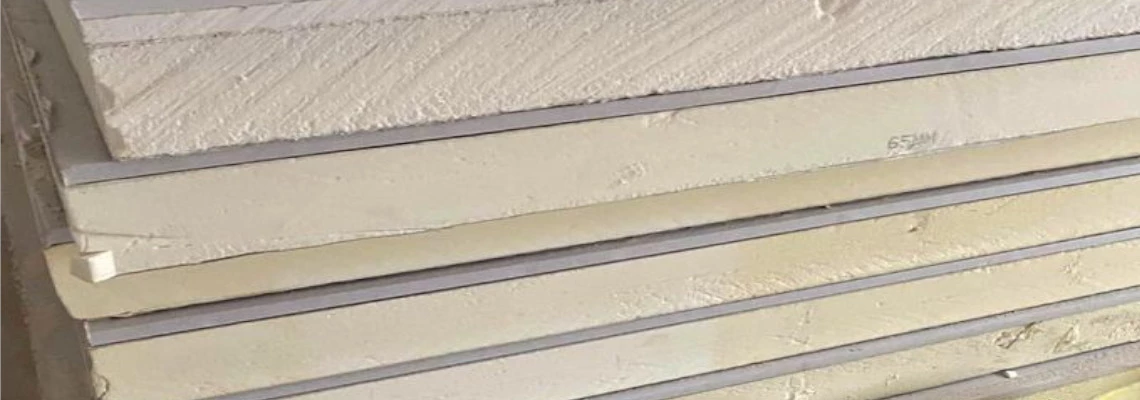
INSULATED PLASTERBOARD THICKNESS *
Insulated plasterboard is a live-changing product, therefore it is incredibly popular due to the reduction in labour and construction times. Because insulated plasterboard can be used in so many different situations, it is important to know what you're getting.
Choosing the right product is one thing, choosing the right thickness is another story.
But don’t worry, with an insulated plasterboard, you are not limited to any thickness. However, it is worth anticipating it to be anywhere from 22mm to 120mm. The thickness of the insulating sheet can vary, depending on the insulation level needed. Let's take a closer look at available insulated plasterboard thicknesses. By reading this article you will find out what thickness of insulated plasterboard you should use.
TYPES OF INSULATED PLASTERBOARD
There are many different types of insulation laminated to plasterboard. This combination product offers either PIR core, Phenolic foam core or EPS (polystyrene) core. Depending on the design, you can choose from various types of insulation setups. Moreover, boards are available either in standard or moisture resistant versions. Thermal insulated boards are bonded to 2 types of plasterboard. Either 12.5mm or 9.5mm wallboard. The best and popular thicknesses are: 22mm, 25mm and 62.5mm. All boards are easily applicable measuring 2400mm x 1200mm.
Insulated plasterboard range comes from well-known brands Celotex, Xtratherm, British Gypsum, Knauf and Kingspan so you're free to take your pick between whichever suits you.
INSULATED PLASTERBOARD THICKNESS
Insulated plasterboard comes in several varieties and their thickness depends on the selected insulation option.
Low grade insulated plasterboard such as British Gypsum Gyproc Thermaline or Knauf Thermal laminate is commonly used in ceilings and window reveals where a basic level of thermal insulation is required to reduce heat loss from buildings.
Therefore, a board thickness of 22 mm would be the best for this type of situation. Moreover, the insulated plasterboard variant with EPS is the cheapest insulation product available on the market, hence its popularity.
THICKNESS: 22mm-50mm
APPLICATION: window reveals, ceilings, single internal wall, staircases
PRODUCTS:
Gyproc Thermaline Basic Insulated Plasterboard
Knauf EPS Thermal Laminate Insulation Board
Where 50% or more of the internal wall is being renovated, building regulations would normally apply, and the thermal insulation of the wall would have to meet the standards required by building regulations approved documents. When new layers are added to a thermal element through being dry lined internally the U-value of 0.30W/m2K is required. According to building regulations insulated plasterboard should normally be at least 60mm thick, and can be up to 100mm. Here, Celotex, Xtartherm or Kingspan are the best products of choice offering 62.5mm insulated plasterboard that passes the magic point of 0.3. Looking at an example of Kingspan K118 U-value for a solid wall with no insulation you want to be looking at a minimum of the foam element of the plasterboard of 50mm.
THICKNESS: 62.5mm-122.5mm
APPLICATION: ceilings, new build wall, external walls – internal lining, refurbishment walls (if more than 50%), pitched roof
PRODUCTS:
SR/TB Safe-R Thermal Liner Xtratherm Insulated Board
Kingspan K118 Insulated Plasterboard
Xtratherm XT/TL Thermal Liner Dot and Dab Insulated Plasterboard
Celotex PL4000 Insulated Plasterboard PIR Thermal Laminate

To find out how hot to fit insulated plasterboard click here.
ONLY FIRST 100 MM MATTERS
If you insulate the outer wall from the inside, you need to know that the first centimetre of internal wall insulation will do more than the next and so on. In fact, the first 100mm of insulation is where the energy savings are really significant.

Related articles:
How to fit insulated plasterboard
5 Benefits of Insulated Plasterboard
How To Dot & Dab Wall Insulation Boards
Energy saver insulation. How to improve thermal insulation levels in your home?
Rigid insulation board bonded to plasterboard. How does it sound?
Internal wall insulation - is it risky?
*All the information provided in the content published on Insulationgo blog is for informational and educational purposes only. Insulationgo LTD makes every effort to ensure the accuracy and timeliness of the content, but we do not assume any responsibility for any errors or omissions.
The information presented on this blog should not be considered as professional advice or a substitute for consulting relevant experts. Before making any purchase decisions or taking action based on the information presented here, it is strongly recommended to contact the product manufacturer directly to verify the details and ensure its suitability for your specific needs.
By using this blog, you acknowledge and agree that Insulationgo LTD shall not be held liable for any damages, losses, or inconveniences arising from the use or reliance on the information provided herein. This limitation of liability applies to all users of the blog, including but not limited to visitors, readers, and subscribers.










































































































